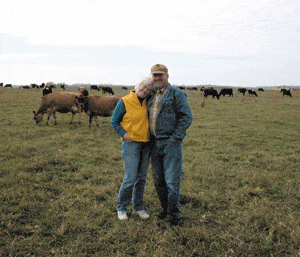[A version of this story originally appeared in The Cultivator, The Cornucopia Institute’s quarterly print publication available to members and online.]
My Road to Organics
Do you remember what sparked your decision to farm organically? Or to switch from heavily processed food to fresh, local, organic fare? Perhaps it was illness. Or concern for the environment and animal welfare. Maybe you wanted to protect your children’s health. Each of us has an aha! moment or moments. In this issue, Cornucopia board member Dave Minar tells how he came to farm organically at his family’s 100% grassfed dairy in Minnesota.

MOSES Farmers of the Year in 2007
My organic story best begins with my entrepreneurial ancestors: a grandfather who was able to buy farms for all three of his sons and was a master craftsman who built his own retirement home in town, and then built a home for his daughter and son-in-law. His new home had a large root cellar that was filled with potatoes that were grown on his youngest son’s farm every fall. Although crippled by arthritis, Grandfather’s potato business was a major source of his retirement income and was a way for him to be connected to his community, as almost everyone in our town came to buy his potatoes.
My father, who was his oldest child, was very fond of horses and started a stud horse business with a beautiful Percheron stallion. I still have his logbook where he described all the mares that were serviced with the date and the owner. Inheriting some carpentry skills, he proceeded to build his own barn from a huge wind-fallen tree. Of course, Grandpa was there to supervise. When new technology come to agriculture in the late ’30s, my father purchased a new wire tied hay baler and was hired by many local farmers to bale the wind-blown straw from around their straw piles.
After WWII the munitions plants in this country were converted to pesticide manufacturing. Dad was one of the first in our community to adopt their use in controlling weeds and insects.
My wife Florence and I purchased the farm from my parents in 1969. Having been trained in all the new technologies at the University of Minnesota, we easily adopted their use on our farm.
Three of our children were born in the late ’60s and we wondered what effect the use of pesticides could have on them. Every spring we would see dead birds on our newly planted corn fields, no doubt from eating some of the treated seed that was left on the surface after planting. We began questioning the use of pesticides on our farm.
The watershed moment came in the spring of 1974. I had been spraying a cornfield with an herbicide that came as a wettable powder and was plugging the nozzles of the sprayer. With bare hands I was cleaning the nozzles, when I was overcome by a neurologic reaction. I had to lie down for several hours and wait for the effects to subside. We sold the sprayer that summer and swore that we would never use pesticides again.
We gradually learned the organic-farming techniques of our forefathers, mostly by trial and error. In the ’70s about the only information that was available was from the Rodale Institute. Today, the information exchange is readily available at sustainable farming associations and organic farming conferences.
We learned that corn needed to be planted after mid-May when the soil was warm enough for rapid germination and the farmer had a chance to till the field to destroy emerging weeds. Corn needed to be planted in a field that was in sod the previous year to get the maximum weed suppression. Use of a spike tooth harrow seven days after planting corn was a good way to control early weeds. We relearned the use of a rotary hoe and a cultivator.
During the drought of 1988–89 we came to realize that we were doing the right thing as most of the neighborhood corn was dry and shriveled, and ours was lush and green. We were improving soil organic matter and water holding capacity by farming organically.
DAVE MINAR’s grandfather purchased what is now Cedar Summit Farm in 1926. One of Minnesota’s leading dairy providers, Cedar Summit sells products to over 75 retail locations and at the on-farm creamery. Dave and Florence have 5 children and 12 grandchildren. All of them regularly visit or work at the farm.

